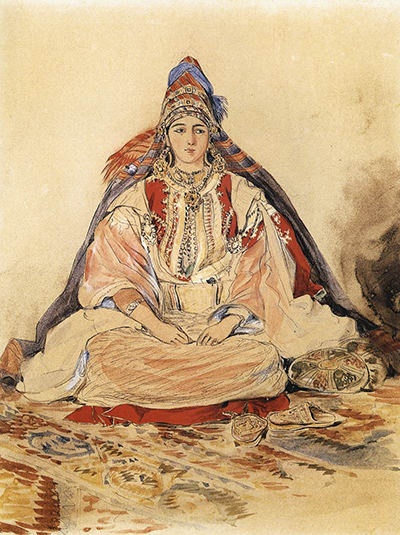He would feature Jewish content many times as well, though it was not easy to find people willing to allow him to create such personal portraits as the one that we find here. He was persistent and always respectful, which eventually paid off. The pretty artwork that we find here is of a young woman sat with her legs crossed. She is dressed in some beautiful clothing of a traditional style and appears to be on some simple rugs on the floor. She has a slightly anxious look in her eyes, though it is hard to tell here because the artist does not implement as much detail as he might normally do. There are simple lines of pencil or pen which create form, and then a careful selection of colour to complete the attractive clothing that is perhaps the highlight of this painting.
The lighter, slightly opaque shapes of colour and that way because Delacroix used watercolours to complete this artwork. He may have found it easier to work in this medium whilst travelling around as many of his landscapes were also completed in watercolours rather than his normal oils that were more common in his studio-based work. This painting is dated at 1832 and in this decade Delacroix produced perhaps more portraits than at any other time in his career. The original piece can be found at the Louvre as part of their extensive collection of his work, though will not necessarily be on display because of the huge size of their collection more generally. Always check ahead, though there will always be something from his career on display.
The artist would fill sketchbooks with notes and drawings during his time visiting countries such as Morocco and would then later refer to them for years to come. Travel at that time was difficult to organise and so it was easier to take as many notes as possible during each visit rather than hoping to return every few years. Paintings such as Jewish Wedding in Morocco, The Fanatics of Tangier and The Sultan of Morocco and his Entourage were all based on these types of sketches and perhaps the painting that we find here of a Jewish Bride is a type of study in a way, where he attempts to record the beautiful attire worn by this young woman. It is also worth comparing all of the paintings mentioned here in order to see how each might influence the other as he continued to investigate these rich cultures.
